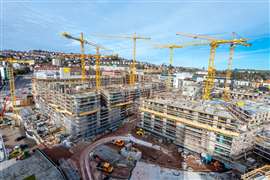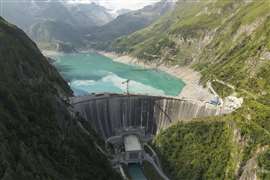Read this article in Français Deutsch Italiano Português Español
Is a long-promised recovery finally here for Europe’s construction industry?
28 October 2025
 Image: Alen Ajan via AdobeStock - stock.adobe.com
Image: Alen Ajan via AdobeStock - stock.adobe.com
A long-anticipated recovery in Europe’s construction sector may finally be taking hold
That’s according to new analysis from global management consultancy Bain & Company, which reports stabilising conditions and early signs of growth across several key markets.
Bain’s latest Building Blocks Construction Indicator forecasts a return to stronger medium-term expansion from 2025 through to 2028, after what it described as a “perfect storm” of headwinds over recent years. The consultancy points to resilient infrastructure investment, pent-up residential demand and “selective” strength in office construction as the main drivers of the upturn.
The outlook contrasts with a sluggish 2024, when construction output fell sharply across Europe and sentiment remained weak in major markets such as France and Germany. Bain’s analysis suggests that interest rate cuts by the European Central Bank, coupled with the end of recent election cycles, are now beginning to unlock private and public investment.
“After a difficult few years, Europe’s construction market is pivoting back to growth from 2025 through 2028, with early momentum already visible in several countries,” said Marc Jeker, partner in Bain & Company’s infrastructure, construction and building products practice. “Resilient infrastructure, a revival in new residential building, and selective strength in office projects are set to drive the upswing – helped by ECB rate cuts, pent-up housing demand, and clearer public-programme agendas.”
Nordics to lead, France to remain subdued
Bain identified the Nordic countries as leading the revival, with construction activity expected to grow at a compound annual growth rate (CAGR) of between 2% and 4% a year until 2028, driven largely by new residential, commercial, and infrastructure projects.
The UK is forecast to record steady broad-based growth of 2-4% with residential, office, commercial and infrastructure construction all contributing, while industrial construction is expected to be relatively softer.
The picture in the Netherlands also appears positive, with a projected growth rate of 1.5% to 2.5%, skewing to new residential construction.
Europe’s biggest economy, Germany, is set to move back into positive territory with a projected 2.5–4.5% annual increase. But that relies on both a residential rebound and a much-publicised €500bn infrastructure fund supporting investment – German construction bodies have recently expressed fears that money in the fund intended to fuel construction work is instead being used to plug governmental budget holes.
Meanwhile, France’s recovery is expected to remain subdued. Bain has forecast growth of 0.5% to 2.5% annual growth overall. While the residential building segment could see growth o 3% to 5%, Bain also warned of potential stagnation in infrastructure spending, resulting from EU deficit reduction mandates.
And Italy, which has recently enjoyed a stronger construction sector than some of its major European counterparts, is likely to be the weakest major market in 2025-2028, facing flat activity as government incentive schemes expire.
The spectre of uncertainty
But Bain cautioned that its medium-term outlook remains vulnerable to wider economic uncertainty – of which there has been plenty in recent years.
Meanwhile, ongoing widespread labour shortages continue to cap the industry’s supply potential. Vacancy rates in construction remain well above the European average, with an ageing workforce and limited inflow of new talent. Leading construction companies, Bain noted, are turning to productivity gains through digitalisation, automation and prefabrication to offset capacity constraints.
The report also highlights rapid advances in AI-driven engineering and project management, which it says are beginning to redefine how work is designed and delivered. Early adopters of digital and AI-based tools are already seeing improvements in cost, speed and execution quality, particularly in the engineering, procurement and construction (EPC) segment.
Positive signs in residential and infrastructure
Bain’s report noted that permit approvals for residential construction projects are stabilising across several markets suggesting that residential construction could pick up pace by 2026. It said it expected new housing to be among the key growth engines through to 2028, particularly in the Nordics, Germany, France and the Netherlands, where structural housing shortages persist.
Infrastructure construction is expected to remain robust across most of Europe, underpinned by multi-year public programmes and, in some countries, new delivery frameworks. Bain projects compound annual growth rates of 3% to 5% in Germany, 2.5% to 4.5% in the Nordics and 1.5% to 3.5% in Italy, where spending under the EU’s Recovery and Resilience Facility will support activity until 2026.
Office construction is forecast to grow modestly in selective markets despite continued remote-work trends, with the UK leading this segment at 2% to 4% annual growth. France’s office sector, however, continues to face high vacancy rates and low permitting levels.
STAY CONNECTED


Receive the information you need when you need it through our world-leading magazines, newsletters and daily briefings.
CONNECT WITH THE TEAM











